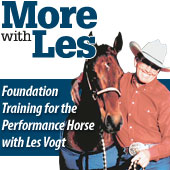 26th in a series
26th in a series
Last issue, Les explained the components of vertical flexion. Now we’ll take a deeper look.
We say a horse is “soft in the bridle” when he has achieved soft vertical flexion – that is, when the horse will drop his nose by rounding his neck and poll whenever he feels light contact with both reins. Your ultimate goal is to get this reaction from your horse before you’ve even taken all the slack out of your reins – like you could ride with silk threads and not break them – wouldn’t that be great! We all dream about it!
But I’ll warn you right now, it won’t happen if you’re still feeling any resistance when you ask for lateral flexion. If you are still getting resistance to either side, you need to keep working that before you start into asking for much flexion vertically. If you ask too soon, you’re likely to create a dull mouth in your horse rather than the soft, responsive one that you’re after. Each step builds upon the one before it, and getting each step perfect, before you move on to the next one, is critical.
Flexion and Collection
Having a horse that is light in the mouth and soft in the poll is a critical part of creating a top performance horse, but it can also be one of the biggest traps there is for many riders. If the drop in the horse’s head isn’t matched with impulsion from behind, driven by your legs, you are going to end up with a horse that is heavy in front, and that is the last thing
you want.
So while we’re looking for vertical flexion, or the rounding of the poll, it is only one component of collection, which is our ultimate goal. And collection comes from driving the back of the horse up to the front with your legs while keeping him round and soft with your hands:
Vertical flexion + Impulsion = Collection
It’s easy to get absorbed into the part of the horse you can see, his head and neck, and forget about the rest. But your results will be better, and you’ll reach them faster if you use your legs too right from the start. In fact, if you were to use just your hands, and I were to use my hands and legs in rhythm with each other, I’m going to achieve vertical flexion twice as fast as you will – and also I’ll be developing collection as I go. So don’t just work on the head now and think you’ll add the leg for the collection later; try to use them both right from the start.
Reward the Thought
Take your time too – you don’t want to ask for too much at once. You don’t have to get the total result from your horse right from the start, but you do want the thought—the gesture—that he is willing to think about giving his nose to the pressure on the rein. When you first ask, your horse could give you a real negative gesture by lifting his neck when he feels the rein – let’s hope not! But a positive gesture would be him thinking, just thinking, about dropping his nose and rounding his neck when he feels you pick up. Always give him a big “atta boy” for positive gestures.
Here is Bellarista, my finalist in the Open 2004 Snaffle Bit Futurity, as a 2-year old. Notice how flexed she is staying even with a little slack, or float, in the rein. Also note the amount of reach she is showing with her hind legs.
EDITOR’S NOTE: More with Les is a regular California Horsetrader column. Les Vogt has won more than 15 World Championships, including two wins at the NRCHA Snaffle Bit Futurity. Although Les still rides and occasionally shows, his focus is giving clinics around the world and developing products for the performance horseman. To learn more about Les and to see his clinic schedule, visit: www.lesvogt.com
Leave a Comment
All fields must be filled in to leave a message.